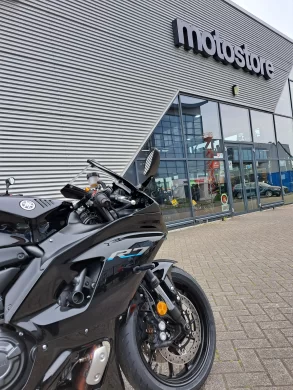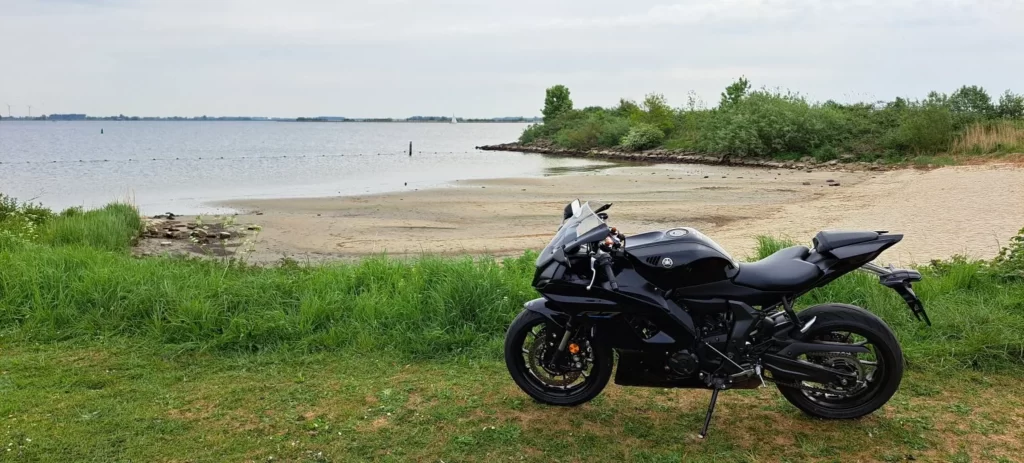Is the new Yamaha YZF-R7 filling the gap in Yamaha’s YZF-R model lineup? With the limitation of their R6 model in 2021 to race-only specifications (and no longer a street-legal version) due to stricter Euro norms, there was suddenly a big step between the R125, R3, and the R1. Enter the A2-legal R7, available in 2 colors and in the World GP 60 Anniversary color scheme
A YZF-R with Yamaha's CP2 engine?
Yes, the new YZF-R7 also features Yamaha’s CP2 engine, the same engine found in the MT-07, Tracer 7, and Ténéré 700. It’s a well-known engine that has proven its reliability across various models. This CP2 engine, a parallel twin with a crossplane crankshaft, comes with several positive attributes. Firstly, the engine is compact, meaning it’s relatively light and doesn’t take up much space in the frame. A lighter and shorter frame is a great starting point for a supersport bike. Secondly, the engine is torquey, which is great for city riding and also makes the R7 very enjoyable on typical Dutch roads full of speed bumps.
Yamaha opted not to reinvent the wheel for their YZF-R7, but instead chose to build upon the proven reliability. However, an off-road Ténéré vs a Supersport R7 rides and behaves quite differently. Nevertheless, the engine doesn’t differ much between them. The full 73.4 horsepower is available on the R7 at 8,750 rpm (vs. 9,000 rpm on the Ténéré). Despite this, the CP2 engine of the R7 has its own character. For example, Yamaha has used a new ECU specification and optimized air intake channels. Additionally, in compliance with the new Euro 5 emission standards, there’s a revised exhaust design and optimized fuel injection settings. An additional feature in the R7’s CP2 engine is the introduction of an A&S clutch (Assist and Slipper). This A&S clutch helps in smoother shifting and prevents the engine from reaching excessively high rpm, reducing the risk of rear-wheel hopping. This results in predictable and manageable behavior when approaching corners. Another benefit of the A&S clutch is that the clutch lever is much lighter to operate. While riding, the clutch lever felt noticeably lighter, though whether it makes as much of a difference as Yamaha claims is debatable. In my opinion, it was lighter than my XT660 and the Suzuki GSX-S950. Besides these adjustments, the Yamaha YZF-R7 also has a slightly smaller reduction factor of the secondary gear set for a sportier character with powerful acceleration. Combined with a short wheelbase, steering head angle, and seat height, you feel like you’re sitting on a completely different motorcycle.


Sporty Sophistication for the Stylish and Agile R7
You don’t need to see the Yamaha logo to know that this stunning new Supersport is part of the R-series. The lightweight, aerodynamically shaped fairing with aluminum lower panels screams R-series. In terms of looks, the YZF-R7 falls somewhere between the R6 and the R1. Some design decisions seem to be a variation of the R6. The YZF-R7 also features the sporty “twin-eye” appearance with the M-shaped air intake channel, which may be recognized from the R6. A powerful central LED headlight is hidden in this air intake channel. Personally, the R7 looks best from a diagonal front view, looking into one of its “twin-eyes.”
The sporty and sleek lines continue to the rear, where the rear frame points more towards the sky than the MT-07. Also, at the level of the seat, there is a thicker subframe reinforcement, combined with a newly designed link-type Monocross rear suspension with damping properties and spring constant. This is tailored as much as possible to the sporty character of the YZF-R7, with the shock absorber placed more horizontally to shift the center of gravity towards the center. The shock absorber is equipped with adjustment mechanisms for spring preload and rebound damping, contributing to greater agility at the rear of the R7.
Sitting on the R7 motivates you to adopt a forward-leaning riding position. The handlebars have been replaced by clip-ons, which bring the levers lower and further inward. The design of the seat, narrow on the inside of the rider’s thighs and wider at the back, contributes to the sporty seating position. The seat also allows for maximum freedom of movement. The previously mentioned position of the clip-ons and the location of the footrests are chosen to enable the forward-leaning riding position, allowing the rider to enjoy optimal control and the greatest possible aerodynamic efficiency. This means that when you want to ride sportily, you really have to lean into the tank, but during leisurely cruising or highway riding, you can still sit fairly upright without putting too much strain on your wrists. Cruising on the highway can easily be done with one elbow on the tank and your helmet supported by your hand. When you lean closer to the motorcycle during sporty riding, you are further supported by the tank cover with knee cutouts, which even offer enough room for me at 1.86m tall. Gripping the tank firmly with your knees is made quite easy by this knee space during braking and in corners. The solo seat provides additional support during acceleration through the bump stop and offers space on the back of the seat for a passenger, although an additional cover can also be ordered.
The R7 is available in two standard color options and in the special 60th Anniversary option. The first color option is Icon Blue, used on the upper fairing parts and on the lower aluminum panels and wheels. The sides of the fairing have a contrasting dark matte blue tint. The second color option is Yamaha Black, with minimal accents. Black is the new black, and personally, this color option looks the best. Both versions come with the engine block, chassis panels, and swingarm finished in Crystal Graphite, accentuating the R7. The R7 is also available in the special World GP 60th Anniversary color scheme, the iconic white body color of the R7 World GP 60th Anniversary with red ‘speed block’ graphics and special 60th anniversary emblem. This special World GP 60th Anniversary with its red front fender, yellow front plate, and gold wheels, embodies 60 years of GP racing. Yamaha has released this edition to honor the famous racing motorcycles and riders who have helped make Yamaha what it is today.


Power, Precision, and Performance
The 689cc CP2 engine of the YZF-R7 delivers 73.4 hp at 8,750 rpm, offering spectacular acceleration and responsive throttle. The 270-degree crankshaft provides an irregular ignition interval, enhancing the YZF-R7’s experience, which becomes more exhilarating as you rev higher. Thanks to its high linear torque, you can accelerate efficiently and exit corners with full throttle. To ease corner entry, Yamaha equipped the R7 with their Slipper Clutch variant, the A&S clutch. The R7 is the first CP2 engine with the A&S clutch, which helps prevent the engine from revving too high and the rear wheel from bouncing. During spirited riding and aggressive downshifting, this should help prevent rear wheel lock-up, promoting predictable and manageable behavior when entering corners. During daily use, you mainly notice that the clutch is easier to operate.
The slim profile of the CP2 engine gives the YZF-R7 the slimmest proportions in the entire R-Series family, contributing to cornering performance on the track and quick, agile direction changes on twisty roads and dikes. The slim design also reduces wind resistance for improved aerodynamics, while the new bodywork is shaped to enhance airflow around the R7. The addition of the new A&S clutch ensures that the R7 is exciting without being intimidating. Without relying on huge horsepower figures, the rider’s skill in carrying corner speed is necessary to extract everything the R7 offers. Yamaha seems to focus on “Smooth is fast” with this package.
LED lighting is found both at the front and rear, including the main headlight and turn signals. The powerful central LED headlight hidden in the air intake channel provides a good and wide light pattern during the day. The “twin-eyes” also play a role here, but they also contribute significantly to the R7’s aesthetics. A new LCD dashboard displays information such as gear position, fuel capacity, real-time and average fuel consumption, water temperature, clock, speedometer, tachometer, and odometer, all controlled from the handlebar buttons. At the front, the YZF-R7 is equipped with dual Brembo radially mounted calipers with 4 pistons, providing strong braking power, even with two fingers on the brake lever. Supported by ABS, the system provides uniform brake pressure, keeping the R7 stable even under spirited braking.


Conclusion
Every aspect of the YZF-R7 feels meticulously designed, from the frame and subframe to the controls on the handlebars. While riding, I quickly noticed myself adopting a sporty posture, especially during faster corners. The tires that come standard on the YZF-R7 and the Brembo brakes provide ample confidence to lean into the curves.
Yamaha has managed to squeeze maximum power from the CP2 engine for the R7 while keeping it accessible for A2 license holders. This is where the strength of the R7 lies, potentially making it the ideal supersport for A2 riders. For me, it’s the best supersport I’ve ridden to date. However, for full license holders, it feels like it’s just missing that extra bit of power and torque. The 689cc CP2 engine is better suited for everyday road use than for track riding, although I haven’t been able to use it on the track, online reviews speak positively about its circuit experience.
Thus, the R7 is a motorcycle that can cater to multiple markets: A2 license holders, full license motorcyclists who don’t immediately want a 1000cc bike, and circuit riders looking for something new within their class. In the right RPM range, the R7 offers a good amount of power and torque, and with the A&S clutch, shifting gears up to the last one is easy. This makes cornering effortless. It leans into corners easily, is easy to correct, and has enough pulling power to accelerate out of corners. It’s a bike that invites fun on the right roads, and I’ve certainly had a blast. And all this for $9,199 or £8210.00 at the time of writing.
In terms of looks, whether in Yamaha Black or the 60th Anniversary special edition, it truly represents the R-series, and the twin-eyes add the finishing touch, in line with Yamaha’s R philosophy.
“Smooth is fast.”
Engine
- Engine: Parallel twin-cylinder, Liquid-cooled, EURO5, 4-stroke, 4-valve
- Displacement: 689 CC
- Bore x Stroke: 80.0 x 68.6 mm
- Compression Ratio: 11.5:1 Ignition: TCI, Electric
- Max Power: 55.0 kW (74.8 hp) at 8,750 rpm (A2; 35 kW (47.6 hp) @ 7,750 rpm)
- Max Torque: 67.0 Nm (6.8 kg-m) at 6,500 rpm
- Transmission: Constant mesh, 6 speeds
Chassis
- Frame: Strong steel diamond-shaped frame with a rigid aluminum center section.
- Front Suspension: 41mm telescopic front fork, adjustable preload, rebound, and compression.
- Rear Suspension: Swingarm, Link-type suspension system, monoshock, adjustable preload, and rebound.
- Suspension Travel: 130mm.
- Front Brakes: Hydraulic dual disc brakes, 298mm disc, 4-piston caliper.
- Rear Brake: Hydraulic single disc brake, 245mm disc.
- Front Tire: 120/70ZR17M/C (58W) Tubeless.
- Rear Tire: 180/55ZR17M/C (73W) Tubeless.
Dimensions
- Length: 2070mm
- Width: 705mm
- Height: 1160mm
- Wheelbase: 1395mm
- Seat height: 835mm
- Ground clearance: 135mm
- Curb weight: 188 kg
- Fuel capacity: 13.0 Liters

Meer Posts
Yamaha MT-09 Y AMT – 2024
Yamaha Neos Dual Battery – weektest (2024)